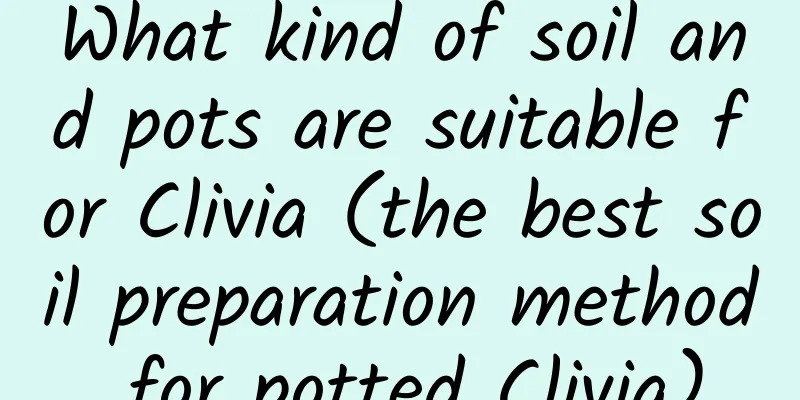What kind of soil and pots are suitable for Clivia (the best soil preparation method for potted Clivia)

How to choose a pot for Clivia①The flower pot must have drainage holes, and the drainage holes cannot be blocked due to soil loss. It is usually necessary to lay a layer of gravel above the drainage holes of the flowerpot before planting Clivia. If there are no gravel, directly laying expanded clay will have a better effect! ② As we all know, if it is a coarse pottery flower pot, its air permeability will be better, but if not, in order to better show the ornamental value of the Clivia potted plant, you can usually choose a ceramic or red brick flower pot! ③ Although the fleshy roots of Clivia grow rapidly, the more roots it has, the less likely the flowers and leaves of the plant will grow vigorously. Therefore, when selecting flower pots, the diameter and depth should not be too large. Generally, the diameter can be controlled between 30 and 40 cm, and the depth of the flowerpot should be controlled within 30 cm. ④ If you choose to plant Clivia indoors, I personally recommend choosing a pot with a tray . This way, no matter when you water it, you don't have to worry about the water in the pot flowing out and flowing to places where it shouldn't flow, affecting the home environment and causing unnecessary trouble to your life and work. The roots of Clivia are fleshy roots . Generally speaking, plants with fleshy roots have stricter requirements on soil. The main reason is that fleshy roots are afraid of waterlogging and root rot, but they also cannot lack water. What is the best configuration for Clivia cultivation soilBecause of the characteristics of fleshy roots, we must ensure good water permeability when preparing soil, and also take into account certain water and fertilizer retention . At the same time, for the growth of Clivia, the soil must contain a certain amount of fertilizer. The soil should be slightly acidic, with a pH between 5.5-6.5 being the best . Based on the above considerations, it is best to match the soil for Clivia with humus soil or leaf mold as the main component . There are many options for soil preparation. The key depends on the resources around you. Here are several soil preparation options for your reference. Option 1: Mix humus soil and coarse sand in a ratio of 4:1. Option 2: Humus, coal slag and river sand are mixed in a ratio of 6:2:2. Option 3: Mix pine needle soil, decomposed organic fertilizer and river sand in a ratio of 5:3:2. No matter what substrate and soil are used, the air permeability and drainage must be good. Daily maintenance methods for Clivia potted plants1. Lighting requirements Clivia is afraid of strong light, so it needs to be shaded in summer. For daily maintenance, it can be placed in a place with sufficient scattered light, and in winter it can be exposed to some soft sunlight. 2. Watering It is best to use rainwater, river water, or tap water and let it dry for two days before using. Keep the soil moist but not wet when watering, and water when the soil in the pot is half dry. 3. Fertilization It is best to use decomposed organic fertilizer, such as cake fertilizer water, soybean water, etc. for fertilizing Clivia. Fertilizer should be applied frequently and thinly, once every half a month. No fertilizer is needed in hot summer days. Before flowering, phosphorus fertilizer can be appropriately added. 4. Temperature The growth temperature of Clivia is 15-25 degrees. It will grow poorly if the temperature is above 30 degrees. In summer, you need to spray water frequently to cool it down. In winter, when the temperature is below 10 degrees, the growth is slow; when it is below 5 degrees, it is in a dormant state; when the temperature is above 0 degrees, the leaves will be frozen to death, or even frozen to death. You should keep warm in winter. |
<<: Which month is the best for rose grafting (the best season for rose grafting tree roses)
>>: What does horsetail garlic look like (how to remedy and prevent horsetail garlic)
Recommend
How to save sunflower seeds
Where do sunflower seeds come from? Sunflower bel...
How to prune potted roses
How to prune potted roses It is more appropriate ...
Which is easier to grow, the fortune tree or the money tree?
There is a certain difference between rosemary an...
Cultivation methods and precautions of Trachelospermum erythrorhizon
Trachelospermum jasminoides is particularly easy ...
Can hydrangea be propagated by cuttings? How and when to propagate hydrangea by cuttings
Hydrangea is one of the more common flowers in li...
How to Eat Beets
Two ways to eat 1. Cold salad: This is the simple...
What are the cultivation methods and precautions for lucky bamboo potted plants?
Introduction of Lucky Bamboo Lucky bamboo belongs...
Where is the best place to plant peony?
Peony Planting Conditions Peony prefers a warm gr...
What is the best season to plant water lilies?
Which month is suitable for planting water lilies...
What are the cultivation methods and precautions for potted azaleas?
Rhododendron Introduction Rhododendron is also ca...
Sweet potato hydroponics video: Put the leftover sweet potatoes in a pot and they will grow into a big bonsai!
Sweet potato hydroponics video Sweet potato hydro...
Can Ligustrum lucidum be planted in the yard?
Can I grow privet in my yard? Ligustrum lucidum c...
Dragon fruit planting
1. Seed processing Dig out the flesh of the drago...
Cultivation methods and precautions of the colorful iron tree
The seven-colored dracaena is relatively easy to ...
How to save broad bean seeds
Broad bean seeds introduction Broad beans have se...









